Results indicate increased food intake, improved growth
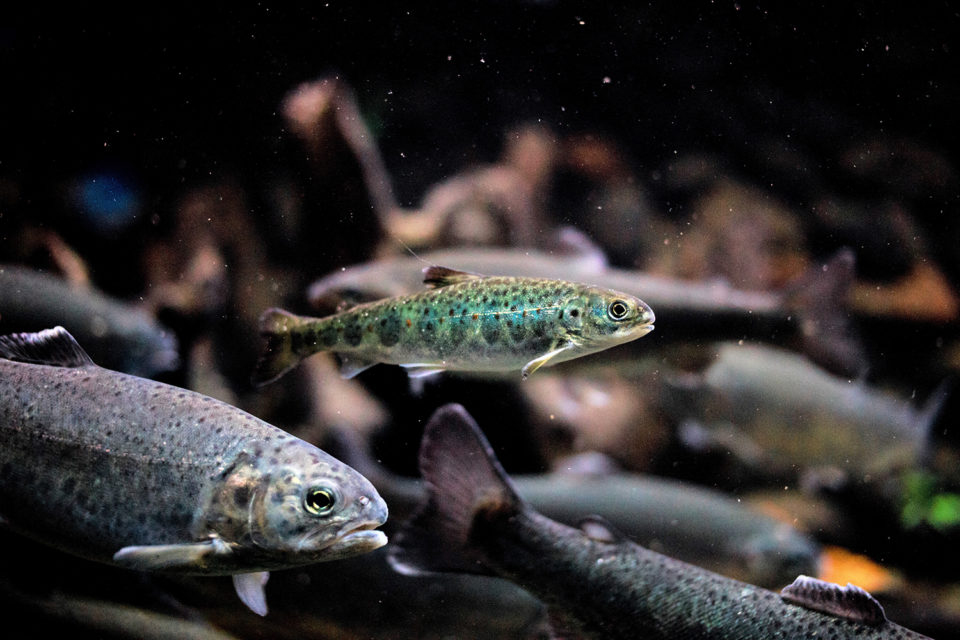
There is continued interest in the use of plant ingredients in aquafeeds, but much remains unknown about the value of aquatic macroalgae (seaweeds) in the nutrition of aquatic animals. The most relevant effects of seaweed supplementation in aquaculture feeds include stimulation of growth performance, enhancement of feed utilization efficiency, improvement of nutrient assimilation, and improvement of fatty acid profile in muscle.
In addition, seaweeds contain a wide array of bioactive compounds and secondary metabolites with potential utility as phytonutrients and nutraceuticals in animal feed. There is much interest in determining if these bioactive compounds can improve the overall health status of fish by enhancing resistance to disease, improving antioxidant capacity, and/or alleviating routine aquaculture stress associated with crowding or events such as handling (e.g., during grading and vaccination) and transportation.
At high inclusion levels, seaweeds have been shown to impair fish growth performance and feed efficiency, so determining the inclusion levels that improve fish growth performance and/or health status remains the primary focus of most relevant studies. Such knowledge could permit the replacement of expensive ingredients of fish feed – such as fishmeal and/or mixing of small amounts of seaweeds or their extracts – with finished aquafeeds to harness the other beneficial effects not related to growth.
However, the variability in the biochemical composition and inconsistent effects of seaweed supplementation among fish necessitates testing the effects of supplementation of specific seaweed on specific fish species. In particular, salmonids are the most important aquaculture fish group and use the greatest volumes of fishmeal and fish oil in aquafeeds; therefore, demonstrating a role of seaweeds in salmonid nutrition would have major implications for aquaculture.
This article – adapted and summarized from the original – assessed the effect of the addition of AquaArom, a commercial meal from brown seaweed or kelp (Laminaria sp.), to feed and the growth performance and other parameters in smolts of Atlantic salmon (Salmo salar). We are grateful to Nicole MacDonald for technical assistance.
Study setup
The feeding trial was conducted at the aquatic facility of the Atlantic Veterinary College, University of Prince Edward Island (Canada). Atlantic salmon smolts (initial average weight: 77 grams) were obtained from Northern Harvest in Cardigan and were maintained and acclimated for one month in a 1,200-liter tank with flow-through aerated well-water. After the acclimation period, the smolts (average weight 92 grams) were randomly distributed in groups of eight in 160-liter tanks comprising triplicates for each of the four experimental groups (control and 3, 6 and 10 percent seaweed supplementation). The tanks were then randomly distributed in a 2 × 6 block within the experimental room. A photoperiod of 12 hours of light and 12 hours of dark was maintained.
The fish were hand-fed the designated diet twice a day for 30 days. After dispensing the food into the tanks, fish were allowed to feed for 1 hour, following which the uneaten food was collected, dried and subtracted from the total amount of food dispensed to estimate food consumption per tank, feed conversion ratio (FCR) and protein efficiency ratio (PER). Bulk fish weights obtained weekly were used to calculate the ration for the following week. On day 30, fish were euthanized, individually weighed and measured. Blood samples were collected, and the fish dissected to harvest livers and viscera.
The experimental diets were prepared in-house by supplementing finished commercial fish feed – EWOS micro crumble for salmonids (Ewos Canada Ltd, St. George, New Brunswick, Canada) – with the required amount of brown seaweed flakes (AquaArom) prepared from kelp (Laminaria sp.) and provided by ADDiCAN Inc., Canada. Diets were calculated to deliver 0 (control), 3 (SW-3), 6 (SW-6), and 10 (SW-10) percent seaweed on a dry matter basis.
For detailed information on the experimental design and diets; analysis of food and seaweed composition; feeding trial and sampling; analyses of biological samples; and statistical analyses, refer to the original publication.
Results and discussion
Analysis of the seaweed showed that it contained 12.37 percent crude protein and non-detectable levels of fat on dry matter basis. Additionally, relative to the control commercial salmonid feed, the seaweed contained lower levels of key minerals (phosphorus, copper, and zinc) and higher levels of neutral detergent fiber (NDF), ash and NaCl. Addition of the seaweed to commercial salmonid feed caused slight changes in the proportion of other dietary ingredients. Notably, the crude protein decreased from 57.6 percent (control) to 52.7 (10 percent seaweed) and from 54.7 to 48.9 percent (as fed basis) in control and 10 percent seaweed-supplemented food, respectively.
To put these values into nutritional requirement context, levels of crude protein in feeds for various age classes of Atlantic salmon range from 42 to 50 percent, with 45 percent for juveniles. Similarly, the slightly reduced levels of phosphorus, copper, and zinc in the seaweed-supplemented diets more than met the respective minimum nutritional requirements for various life stages/size classes of Atlantic salmon. Based on these findings, it is likely that higher rates of inclusion (>10 percent) of this seaweed might decrease levels of key ingredients to levels below their minimum requirements.
There were no mortalities during the 30-day feeding trial; all of the fish in each of the 12 tanks survived and no malformations or other adverse effects were observed. The fish readily accepted the experimental food and the overall effect of seaweed supplementation on food intake (Fig. 1) was significant. Specifically, fish maintained on the seaweed-supplemented diets consumed significantly more food than the control. Consistent with the pattern of food consumption, fish weight per tank varied with seaweed supplementation, with fish maintained on food supplemented with 3 and 10 percent seaweed having significantly higher final body weights than the control.
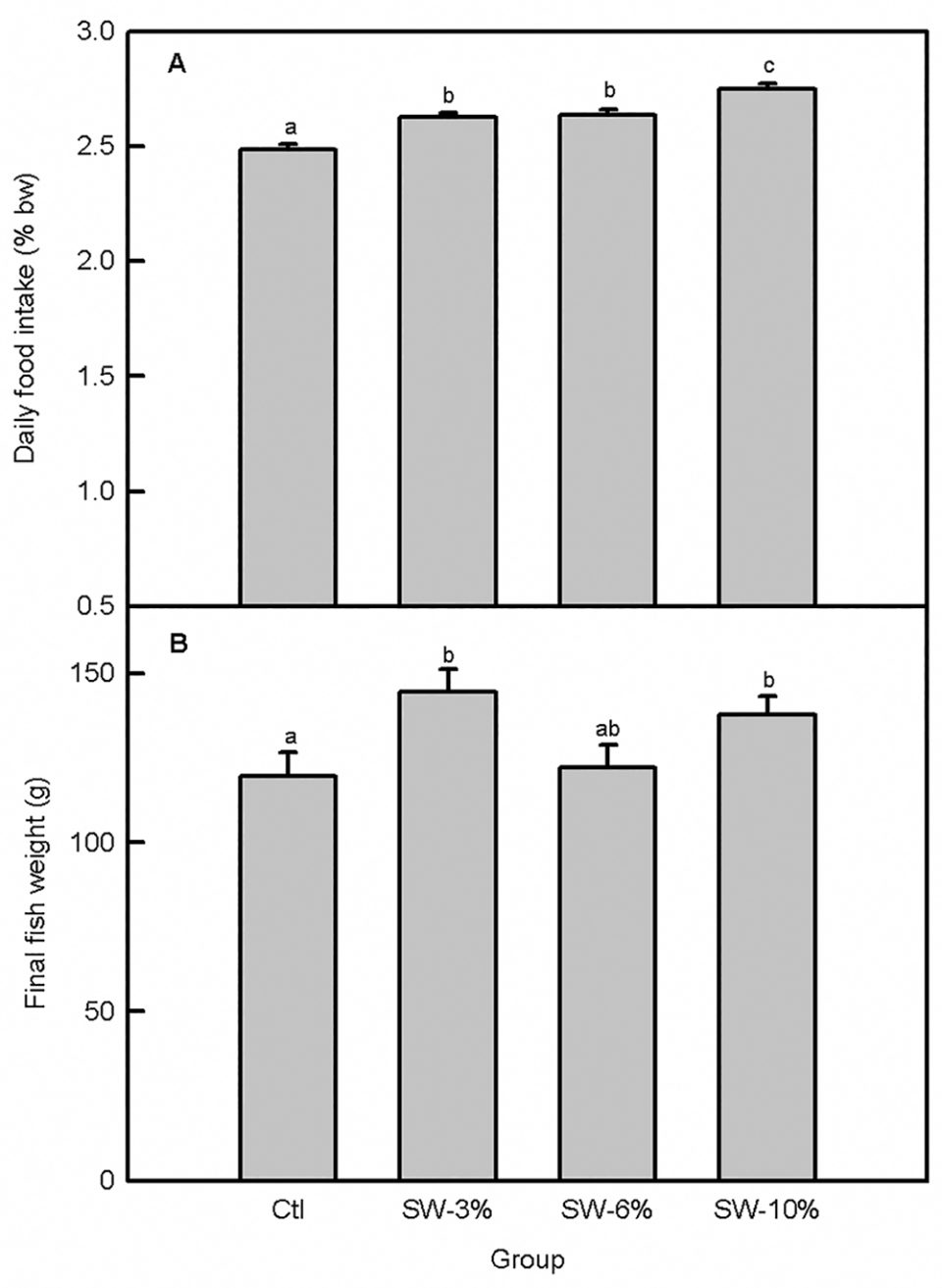
The higher final fish weights relative to the control for the 3 and 10 percent seaweed-supplemented fish were associated with higher percent weight gain, higher daily weight gain and higher specific growth rate, SGR (Fig. 2). Although seaweed supplementation overall did not significantly alter the FCR, the 3 percent supplemented group had better FCR than the 6 percent supplemented group. Moreover, PER was significantly altered by seaweed supplementation (Fig. 3) and was higher in the 3 and 10 percent groups, relative to the 6 percent group.

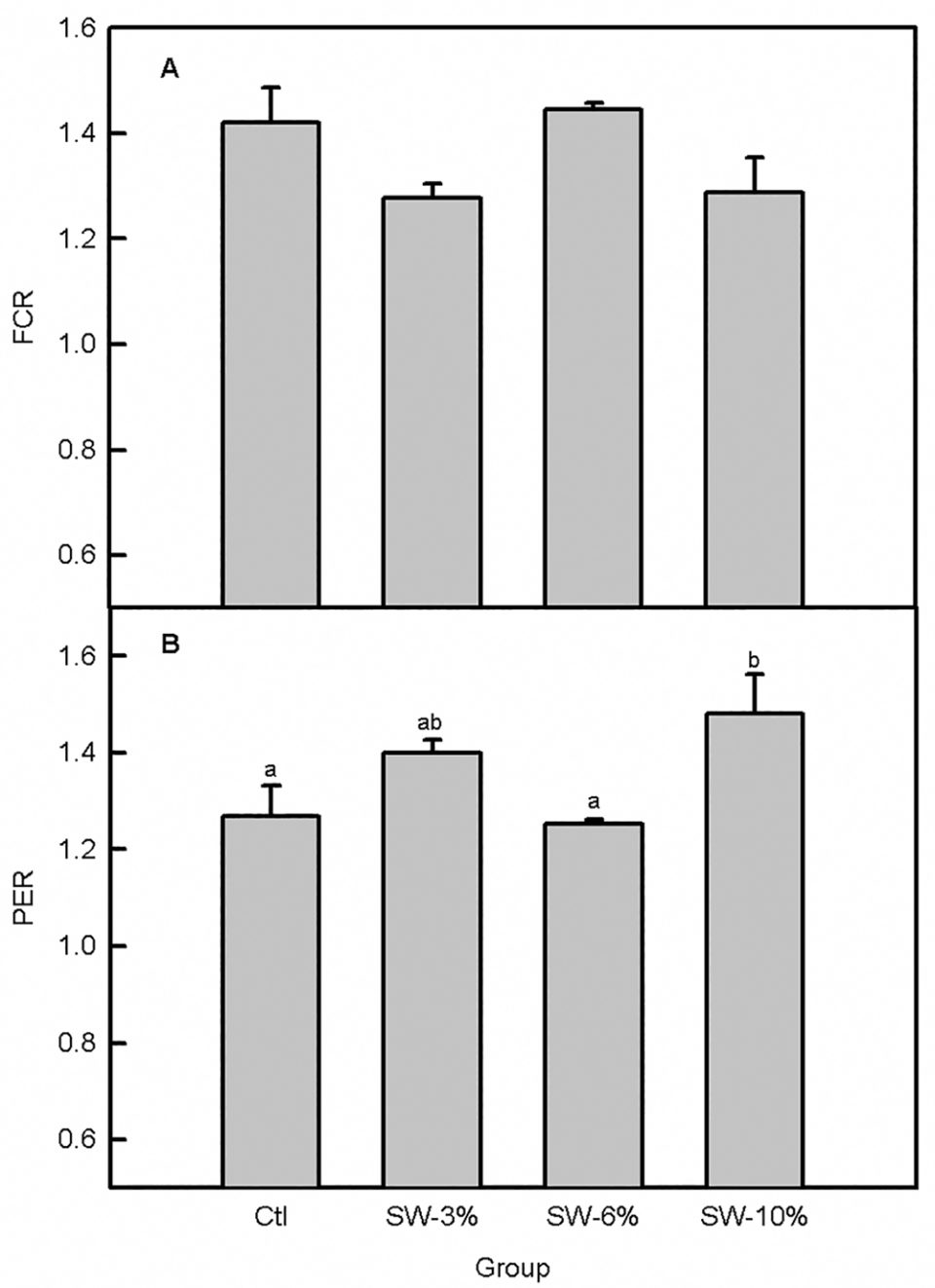
Seaweed supplementation significantly altered fish standard length in which fish that were fed 3 and 10 percent seaweed-supplemented food were longer than the control at the end of the trial. However, Fulton’s condition factor, K (which related length and weight) computed from the final weights and standard lengths remained unchanged (Fig 4). Measurement of other morphometric indices revealed that seaweed supplementation did not alter body depth, hepatosomatic indices (HIS) or viscerosomatic indices (VSI), but it increased weights and lengths of the entire guts and intestines for the 3 and 10 percent supplementation levels relative to the control.
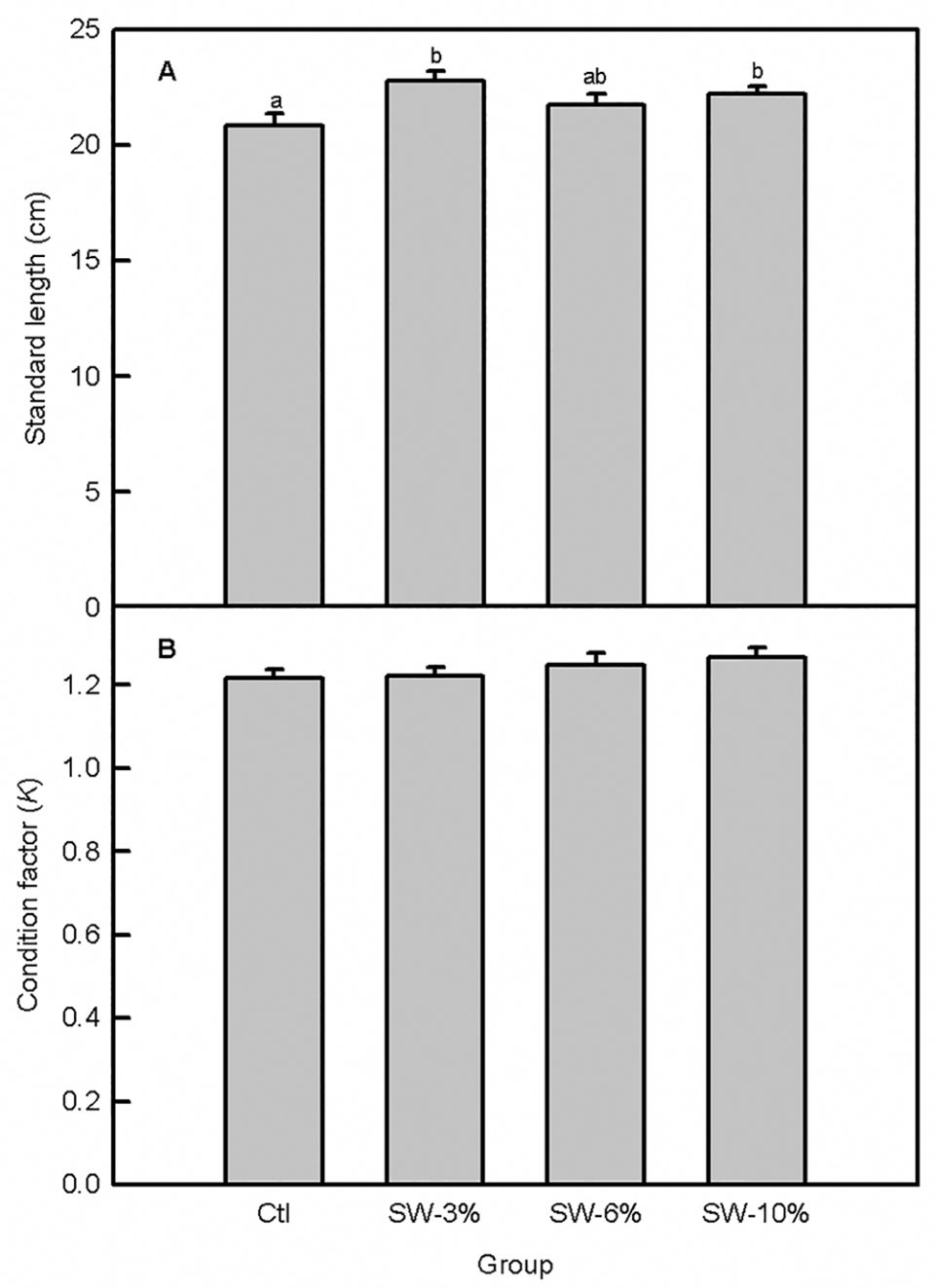
Although seaweeds are considered natural forage for fish, they remain underutilized as an ingredient in aquafeeds. We tested the potential use of seaweed meal derived from brown seaweed of the genus Laminaria (kelp) as an additive to commercial salmonid food using Atlantic salmon smolts. Because of their large size and ease of harvesting, brown seaweeds are generally more amenable to exploitation for animal nutrition than other types of macroalgae. However, brown seaweeds have low nutritional value, containing only 3 to 15 percent crude protein compared with green and red seaweeds that may contain up to 26 and 47 percent crude protein, respectively.
Despite their low protein content, brown seaweeds remain popular as potential animal feed additives because they are rich in bioactive compounds. Indeed, brown seaweeds constitute the majority of seaweed used in terrestrial animal nutrition, but they are the least investigated for application in aquafeeds relative to other seaweed classes.
In our study, Atlantic salmon smolts readily accepted food mixed with 3 to 10 percent brown seaweed. Interestingly, smolts maintained on seaweed-supplemented feed consumed more food than the control. This contrasts the typical finding that inclusion of vegetable protein, particularly in high amounts, in fish diets is associated with reduced palatability and food intake, resulting in decreased growth performance. Regardless, increased intake of seaweed-supplemented fish food has also been previously reported and attributed to the presence in seaweeds of various compounds that attract fish to food, thus enhancing consumption.
Another explanation for the observed increased food intake in our study could be that increased fiber content due to the added seaweed would reduce available dietary energy resulting in increased food intake as a mechanism to compensate for the energy shortfalls. And the addition of seaweed to aquafeeds can improve the texture, integrity and water stability of pellets resulting in higher food consumption.
In our study, supplementation with 3 to 10 percent brown seaweed did not affect survival during the 30-day feeding trial. Importantly, fish fed 3 and 10 percent seaweed-supplemented food exhibited higher daily weight gains, SGR and both final weight and total length than the control, while fish fed 6 percent seaweed maintained growth comparable to the control. Moreover, seaweed supplementation increased PER and imposed a strong tendency to improve FCR. Overall, our findings together with various earlier studies indicate that supplementation of aquafeed with seaweeds at appropriate levels can enhance or not alter growth performance in salmonids.
The enhancement of growth by seaweeds has been attributed to seaweed vitamin and mineral content and/or increased lipid mobilization and assimilation of dietary nutrients. In our study, it is unlikely that phosphorus, copper and zinc contributed to the growth-stimulatory effects because the seaweed we tested contained low levels of these minerals. It has also been postulated that prebiotic activity of seaweed components (e.g., polysaccharides and oligosaccharide) stimulates growth of beneficial bacteria, thereby improving digestion and subsequently growth.
While we did not investigate the mechanisms or causes of the enhanced growth performance, we found that the digestive tracts were heavier and longer in fish fed seaweed-supplemented diets, suggesting a larger surface area for digestion and absorption of nutrients. Longer digestive tracts would increase the retention time of food allowing more time for digestion of seaweed-supplemented diets. Surprisingly, the highest seaweed inclusion level (10 percent) we tested resulted in better growth performance despite a 5 percent-point lower protein content relative to the control. Regardless, the protein contents for all the seaweed-supplemented diets were within the optimal range for Atlantic salmon nutrition.
Overall, while it appears that up to 10 percent inclusion of AquaArom stimulates growth in Atlantic salmon smolts, a longer feeding trial would be necessary for a more definitive conclusion on growth performance. Furthermore, future studies should investigate the mechanisms and components underlying the growth-enhancing effects of this brown seaweed meal.
Our findings are consistent with previous reports that dietary seaweed supplementation modulates antioxidant status and oxidative stress in farmed animals. Thus our study, together with these earlier reports, suggests that dietary brown seaweed supplementation enhances antioxidant capacity directly by increasing levels of antioxidant compounds in circulation/tissues and indirectly by modulating activities of antioxidant defense systems.
Perspectives
Overall, our study shows that the addition of the seaweed meal to commercial salmonid feed increases food intake and enhances growth performance, improves plasma antioxidant capacity, and alleviates the effect of temperature rise on mitochondrial respiration. The slight decline in crude protein and minerals resulting from the addition of up to 10 percent seaweed meal to aquafeed appear to have no adverse consequences on Atlantic salmon smolts. Thus, mixing of this brown seaweed meal with commercial aquafeeds (and potentially feeds for other farm animals) could offer a cost-effective way of harnessing the beneficial effects of seaweeds in animal production.
Now that you've reached the end of the article ...
… please consider supporting GSA’s mission to advance responsible seafood practices through education, advocacy and third-party assurances. The Advocate aims to document the evolution of responsible seafood practices and share the expansive knowledge of our vast network of contributors.
By becoming a Global Seafood Alliance member, you’re ensuring that all of the pre-competitive work we do through member benefits, resources and events can continue. Individual membership costs just $50 a year.
Not a GSA member? Join us.
Authors
-
Collins Kamunde, Ph.D.
Corresponding author
Department of Biomedical Sciences, Atlantic Veterinary College
University of Prince Edward Island, Canada[97,99,46,105,101,112,117,64,101,100,110,117,109,97,107,99]
-
Ravinder Sappal, DVM, Ph.D.
Department of Biomedical Sciences, Atlantic Veterinary College
University of Prince Edward Island, Canada -
Tarek Mostafa Melegy
Department of Biomedical Sciences, Atlantic Veterinary College
University of Prince Edward Island, Canada
Tagged With
Related Posts
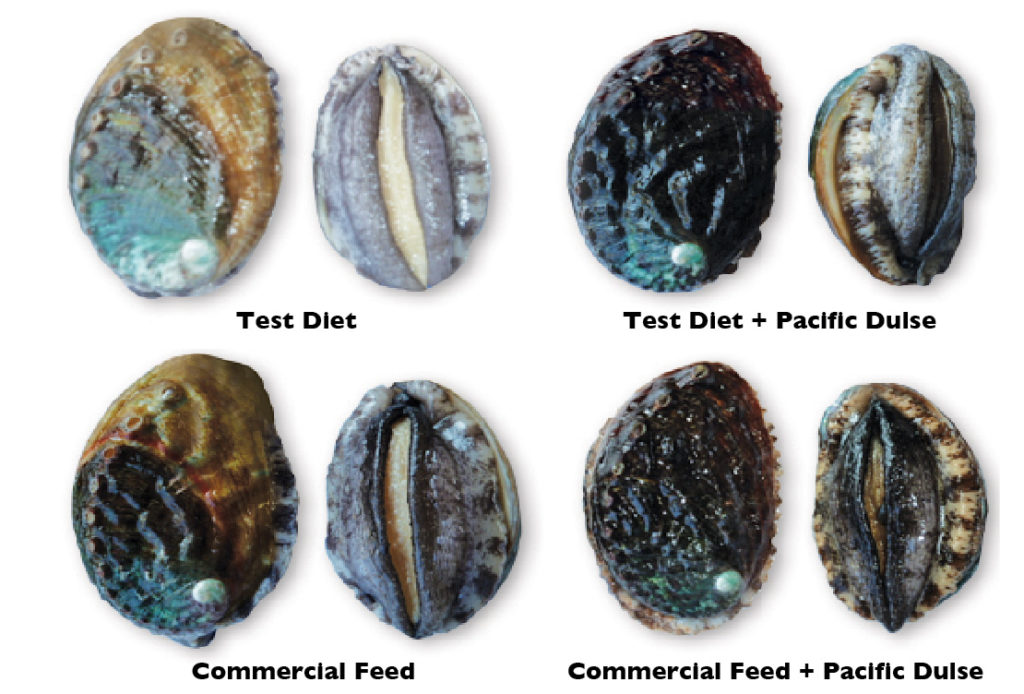
Health & Welfare
Diets affect abalone meat quality, shell color
A preliminary study investigated the effects of diet on the meat quality and shell color of Pacific abalone. A test diet and a commercial abalone feed resulted in lower meat protein content compared to that achieved with a diet of Pacific dulse seaweed. The artificial diets also caused the abalone to have yellow or orange shells. The seaweed diet alone resulted in abalone with dark-brown shells. However, a combination of seaweed and either artificial diet improved abalone growth, meat quality and shell color.
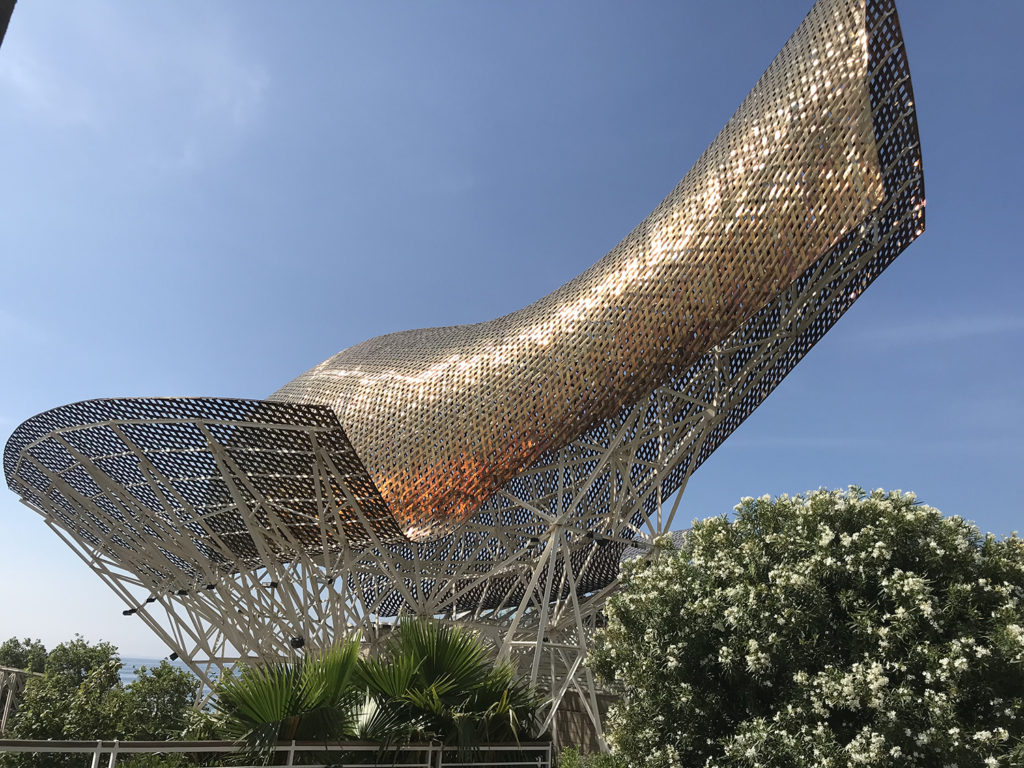
Innovation & Investment
SeaWeb Seafood Summit: Can impact investment ‘save’ aquaculture?
Impact investment, which seeks environmental and social returns in addition to profits, was examined during a SeaWeb Seafood Summit panel.
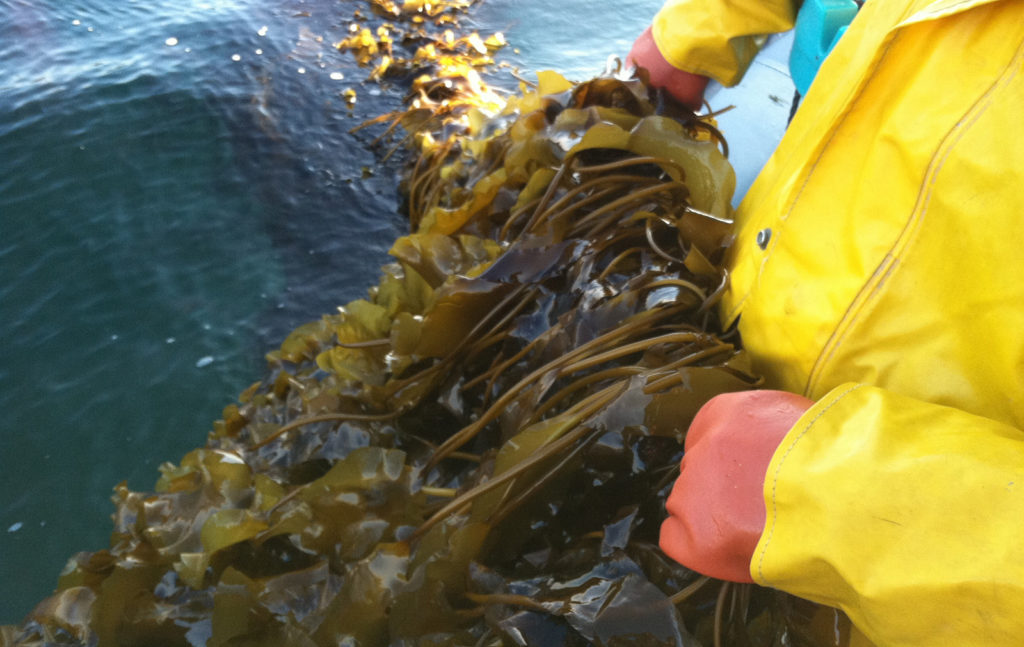
Responsibility
Lean and green, what’s not to love about seaweed?
Grown for hundreds of years, seaweed (sugar kelp, specifically) is the fruit of a nascent U.S. aquaculture industry supplying chefs, home cooks and inspiring fresh and frozen food products.
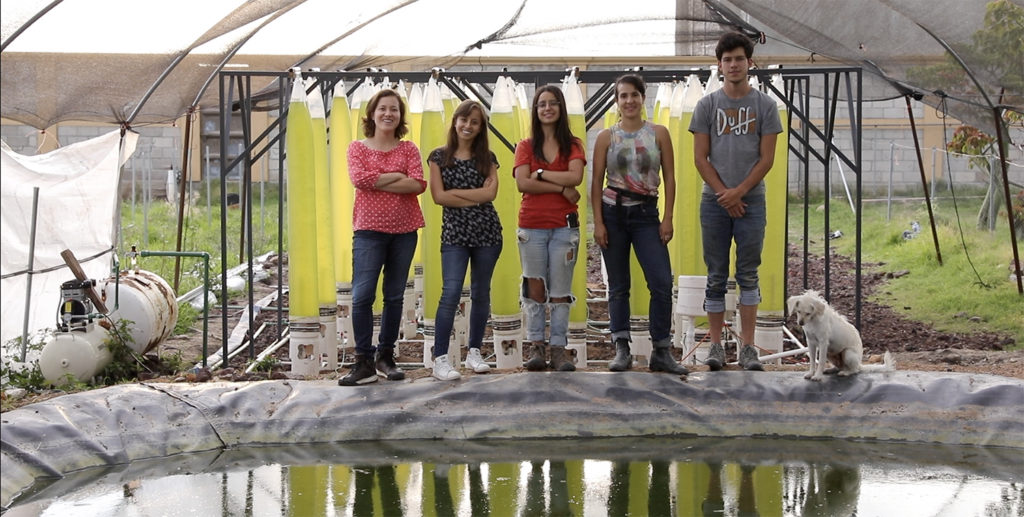
Aquafeeds
Mexican startup offers DIY aquafeed solution by upcycling wastewater
MicroTERRA is a promising Mexico-based startup developing systems that use microalgae to turn fishpond wastewater into protein for fish feed.


